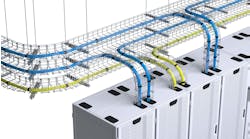Natural Language Processing: How This Technique Can Take Your Business to the Next Level
In this edition of Voices of the Industry, Jim Carson, Data Science Manager at Service Express, shares how natural language processing techniques can automate tasks and increase accuracy in your organization.
Jim Carson, Data Science Manager at Service Express (source: Service Express)
The future of the data center will rely heavily on artificial intelligence (AI) and machine learning (ML) to improve business processes. As mentioned in our previous article, Streamlining Data Center Tasks With Machine Learning, many CIOs and technology leaders are already adopting an AI strategy in their IT departments. One ML technique that stands out as a focus of recent adoption in the data center due to its unique capabilities to analyze unstructured text data is natural language processing (NLP).
Source: Service Express
According to IBM’s Global AI Adoption Index, around half of organizations are using applications powered by NLP and over a quarter expect to implement them over the next year. The pandemic proved to be a catalyst that accelerated business plans to leverage these opportunities. With thoughtful planning, large amounts of data, and the right models, NLP can help IT departments streamline processes, remove human error and improve the customer experience.
How Does NLP Work?
Natural language processing is a type of AI that assists programs in understanding and interpreting human language. NLP fills the gap between human communication and computer understanding. NLP techniques typically analyze large bodies of unstructured text data, including documents, log files, transcripts, etc. The output of an NLP model can vary depending on the desired results. For example, Amazon built Alexa to identify speech patterns and infer meaning or complete a task to assist the user. Recent advances have enabled the NLP field to evolve from tools like spell check to more sophisticated apps such as customer service chatbots, real-time voice-to-text translators, Google Assistant and more.
How Your IT Department Can Improve Processes With NLP
NLP has the potential to accelerate and automate tasks in your IT department so you can streamline solutions. Examples include:
- Automating help desk ticket responses
- Identifying trends in equipment error logs
- Rerouting emails depending on keywords
- Analyzing customer contracts for accuracy
When it comes to NLP, there is no cut-and-dry formula. You have the autonomy to create a model that supports your company and its unique needs. We often see companies invest in expensive software to analyze their data to determine various outcomes. By leveraging your proprietary data with a customized NLP model, you can tailor the results to your business needs far more closely than a pre-packaged solution.
With open-source software, your team can create the same ML and NLP models the software companies are pitching. Instead of settling for a premade solution, we made our own to help engineers provide a quick and reliable resolution for our customers.
Diagnosing Data Center Hardware Failures with NLP
Before planning our NLP project, our Data Science team was tasked with increasing our first-trip fix rate and assisting engineers in a more accurate repair for customers. This is where the idea for PartsRx™ was born. To provide prompt data center maintenance, identifying the issue behind an equipment failure is critical. We needed to find a way to quickly and accurately diagnose a repair solution to ensure minimal downtime for the customer.
When we built the model that would recommend a list of possible solutions and probabilities, we used current and past service ticket data to analyze suspected part failures. The most time-consuming part of the process was collecting and cleaning the data. Once our Data Science team established the foundation, we started translating the data into an easy-to-process format. The next step was to train and test the model. Over a year later, we implemented PartsRx™ to our production platform and rolled out the final program to our service team.
Our Data Science team retrains the NLP model monthly to learn from our evolving service ticket database, improving its real-time accuracy. Adding new data assists the model in creating more accurate diagnoses, leading to faster solutions and improved first-trip repair rates.
Source: Service Express
PartsRx™ is not a replacement for our engineers’ own knowledge and experience. Instead, it’s an additional support resource contributing to our 97% first-trip repair rate and compliments our engineers’ expertise for a streamlined and successful repair.
Follow These 5 Steps to Jumpstart Your NLP Model
#1: Identify the goal(s)
These can be macro or micro goals. Do you want sales emails to fall into a classification system or transferred to specific departments based on keywords? Perhaps you want to build a customer-facing knowledge base that allows customers to resolve their problems through FAQs, troubleshooting guides, etc.
#2: Extract and collect data
Now is the time to compile the data that will help the model create an outcome. Examples of data are log files, transcribed phone calls, emails, product reviews, etc.
#3: Feature engineering
This step is to prepare and extract features from the data that make it easier to interpret. To speed up this process, we use various open-source programs when possible.
#4: Train & Test
We train the model via a supervised learning method. Next, the model is validated on the test data set, then adjusted and fine-tuned.
#5: Deploy
Once the model is ready, it is integrated into a production element, for example, your company ERP or CRM (e.g., Salesforce).
Creating an NLP model to solve complex problems in your organization is more attainable than you may think. There are plenty of free quality resources to help you get started. Although it takes time, a clear understanding and the willingness to make a few mistakes along the way can open new doors for your IT department in improving outdated processes and accuracy by eliminating human error.
Jim Carson is the Data Science Manager at Service Express, a global data center solutions provider that helps IT teams control costs, optimize infrastructure strategies and automate support.





